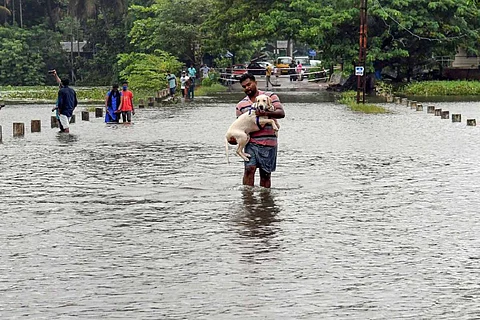

Normally – at least by what used to be normal standards till a few years ago – the southwest monsoon in Kerala should have ended by the end of September. October to December is the time of the northeast monsoon, the one that comes with thunder and lightning. This year, all of that has been disrupted. Neither has the SW monsoon retreated on time, nor has the NE monsoon set in, but Kerala has already received 84% of its share of what should have been the northeast monsoon. In the last few days rains have fallen almost without a break in many parts of the state, claiming at least 17 lives, washing away houses, and damaging infrastructure.
“At the root of it is the low pressure area formed in the Arabian Sea. There were some reports of cloud bursts causing the rains but the India Meteorological Department (IMD) has confirmed that it is not the case,” says Rajeevan Erikkulam, who works with the Kerala State Disaster Management Authority.
The IMD has predicted the low pressure formation as early as October 12, he says. However, when the clouds remained relatively calm for the next two days, people threw caution to the wind until the rains started falling without mercy. On Saturday, October 16 morning, after a night of incessant rains, the IMD quickly issued red warnings to six districts. Reports of damage and destruction came from one part of the state after another – mostly from the districts of Kottayam and Idukki. Landslides took several lives, children among them.
It brought back memories of the devastating August floods of 2018 and 2019. But why is this havoc being wreaked in mid-October, many asked.
“Statistically the rain we are getting now would fall under the northeast monsoon, since it is already October. But scientifically it is still the southwest monsoon, which has not yet fully withdrawn,” Rajeevan says.
Normally, the SW monsoon begins to retreat from Rajasthan by September 17 and from the southern states by October 15. This year, the Rajasthan withdrawal itself began late – by October 6.
“Even though it is generally considered that SW monsoon is from June to September in Kerala, that only refers to the core zone. It only retreats from the tip of peninsular India by November 30. By then we also get the northeast monsoon. Sometimes it so happens that we get a mix of both – the southwest monsoon in the day and the northeast monsoon in the evening with its thunder and lightning. Neither can be called the cause of the rain we are getting now but the low pressure area in the Arabian Sea, where both the monsoon winds converged,” says meteorologist Venu G Nair.
#KeralaRains #HelplineNumbers #Kerala pic.twitter.com/D3WSuakRg9
— The News Minute (@thenewsminute) October 17, 2021
The low pressure that has formed now is not part of the SW monsoon, he says. If a low pressure is formed within the duration of the monsoon period, it is called monsoon depression, and it is different. “Earlier there'd be tropical cyclones in the post monsoon period (October – November) but it wasn’t happening in the Arabian Sea. In the last few decades, however, there has been a drastic change in the Arabian Sea. While the Bay of Bengal went into a cooling phase, the Arabian Sea went into a warming phase. That’s why you see more storms. The changes in the Arabian Sea help the low pressure move alongside the coast,” Venu says.
The changes – or the heating -- in the Arabian Sea came from the southern Indian Ocean, he adds. And those in turn came from the Pacific Ocean, all oceans being connected through conveyor belts. Venu points to anthropological reasons – or human interventions -- as the root of all the changes. “At least 40% of the carbon pumped into the ocean by countries – especially east Asian nations like China – is absorbed by it. When so much of carbon is absorbed it leads to ocean heating and then thermal expansion. So the ocean heat has increased over the years,” he explains.
But in 2018, two researchers found that there was cooling in the Pacific Ocean and they wondered if there was any change in global warming, Venu says, “But it turned out that the Pacific Ocean was dumping excess heat to the southern Indian Ocean through the ocean conveyor belt. And through western boundary currents the heat got pushed to the Arabian Sea. You can say the ultimate culprit is man.”